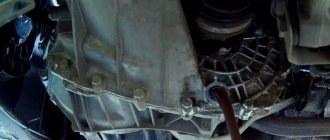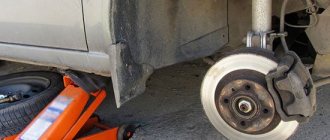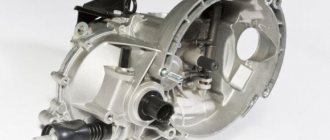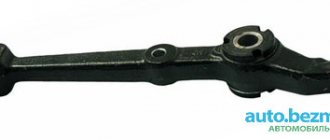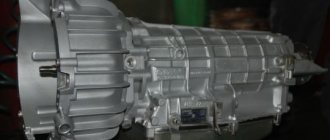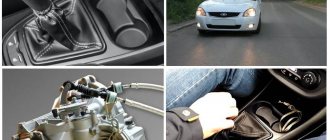All texts were written by me, are authored by Google, included in the original Yandex texts and notarized. For any borrowing, we immediately write an official letter on company letterhead in support of search networks, your hosting and domain registrar.
Next we go to court. Don’t try your luck, we have more than thirty successful Internet projects and have already won a dozen lawsuits.
Source
We understand the manual transmission priors, instructions - how to remove and what's inside
The gearbox is the main unit after the engine. The Priora manual transmission is a reliable, modernized unit from 2110. The Priora's mechanics are filled with 3 to 3.5 liters of oil. Russian cars are chosen for their relative reliability, cheap spare parts, and endurance. If we take the manual transmission, then this is a reliable, unpretentious unit - although the box howls in 2nd gear, even when the car is new. The sales leader from 2012 to 2016 was the Lada Priora, especially in the Caucasus and CIS countries. It is well equipped and has decent technical characteristics. Since 2014, it has been possible to find cars equipped with an automatic transmission. The weakest Priora engine has a power of 87 horsepower, depending on the body type. The initial configuration of the Priora is a 1.6-liter eight-valve engine. It is equipped with a manual transmission.
Made with German precision
When this concept was transferred from paper to a real exhibit, and the mechanism began to work correctly, the module went to Germany, to. The Germans brought the knot to fruition. The company has long been developing various transmission systems and manufacturing engines. German experts carefully looked at the development of Russian engineers and proposed the following. Using a 3D center plate instead of a locking spring return system would make more sense. The special spatial shape of this plate was calculated using computer programs and manufactured using high-precision equipment. This accuracy is due to the fact that a special locking ball moves along the plate. And it is the plate that regulates the effort when selecting and engaging gears. The characteristics that the new cable gearbox will have were selected using a simulation stand. The man sat down on a chair and switched on various gears. Automatic systems simulate shift patterns, lever forces and strokes. And just like that, in small steps, the Germans managed to find the optimal settings. With the help of a computer, parameters and a mathematical model were selected, according to which these plates would then be manufactured.
Characteristics of the Lada Priora gearbox
The base of the gearbox is represented by the following units:
- Clutch housing;
- Rear transmission starter flap.
Transmission housing;
All elements are connected to each other with fixing nuts and sealant. The design is protected from contamination by means of a magnet that retains waste metal products. The main shaft is a set of gears that, when rotated, are connected to additional gears of all speed modes. The additional shaft is designed to regulate and distribute the oil emulsion.
There are two types of bearings installed on the gearbox shafts: ball bearings in front, roller bearings in the rear. In order to connect with the outside atmosphere, a breather is provided. It is located at the top of the node.
The AvtoVAZ model has two types of transmission: controlled by traction or cables. The mechanism of action and design of both options are radically different from each other.
Manual transmission diagram
The design of the manual gearbox is based on the two-shaft design used in the 2170 gearbox of previous generations of Lad, where the transmission of torque from the engine flywheel to the gearbox input shaft is realized through a single-plate clutch mechanism. Then through a gear transmission to the driven shaft and subsequently to the main transmission gear, which drives the front wheel drive differential.
General scheme
The Lada Priora gearbox diagram shows that the gearbox consists of a unit arranged in a two-shaft configuration, responsible for changing speeds and representing two parallel shafts - the drive and the driven, which are in constant mesh through a series of gears having different gear ratios. There are five gears, corresponding to the number of speeds, and one for reverse speed. All gears are in constant mesh and rotate freely on the secondary shaft. The selected gear is engaged by means of a coupling sliding on splines along the secondary shaft, which meshes with the corresponding gear.
Gearbox diagram
The main gear gear is directly connected to the secondary shaft, transmitting torque to the differential assembly and then through the axle shafts to the wheels, as shown in the sectional diagram of the Priora gearbox.
Controlled by the speed selection lever in the cabin, the gear selection mechanisms of the Priora manual transmission can be equipped with rocker or cable drives, which causes a significant difference in the design of the boxes. In Lada Priora cars, a cable-driven gearbox differs from a rocker gearbox:
- changing the location of the gear on/off unit
- different bevel angles of the gear teeth;
- the use of a modernized multi-cone synchronizer for model 2181 between the first and second speeds in order to eliminate extraneous sounds when moving from first speed to second.
It also differs in the volume of transmission fluid used and some other features.
Primary shaft
The primary shaft of the box is connected at one end to the clutch disc by means of a splined engagement, and the other end is fixed in its housing by means of a rear ball bearing. The transmission gears, integral with the input shaft, are constantly engaged with the gears on the secondary shaft, which rotate freely on bearings. To transmit torque to the secondary shaft, the corresponding selected gear speed is fixed.
Secondary shaft
The secondary shaft has a hollow design to ensure free access of transmission lubricant to the rubbing surfaces of the gears. The transmission of torque by the gears is ensured by a locking clutch that moves on the splines of the driven shaft. The movement is carried out using a fork connected to the corresponding drive of the speed selection unit. One clutch switches between adjacent speeds - first and second, the other clutch - between third and fourth, rigidly locking the selected gear.
Gears and synchronizers
The inclusion of speeds is realized by fixing the corresponding engagement of the helical gears of the drive and driven shafts. To do this, a coupling sliding on splines along the secondary shaft is used, through which the selected gear is fixed to it. Thus, torque from the input shaft is transmitted to the secondary shaft and then to the main drive gear of the differential drive.
Gears
Silence of gear shifting is ensured by the use of synchronizers - devices that equalize the rotation speeds of the gear and the secondary shaft using the friction force between the conical tip of the gear and the locking ring. When the angular velocities coincide, the coupling splines engage with the crown of the given gear without interference and the speed is switched on softly. Gear ratios can be found in a special table.
Gear shift mechanism
As the diagram of the Priora gearbox shows, the function of turning the speed on and off is provided by a fork that moves a clutch sliding along the splines of the driven shaft, connecting it with the selected transmission gear. The choice and fixation of the fork occurs through the scenes or cables.
The Priora gearbox with a rocker drive connected directly to the speed selection lever is the simplest technical solution. However, the oil-immersed shift mechanism requires a lot of effort at low temperatures, and the seals tend to leak constantly. To troubleshoot problems, it is often necessary to remove the manual transmission from a Lada Priora car and disassemble and reassemble it.
The cable drive on AvtoVAZ cars eliminates the need to use transmission oil and mechanically move the rocker under the bottom of the car.
The gear shift drive unit is located in a convenient location (on the top of the box) and can be removed and inspected without completely dismantling the manual transmission. A cross-sectional diagram of the Lada Priora gearbox will help you clearly see the placement of components and related mechanics.
Gearbox
The function of the gearbox is performed by the main pair - a bunch of the front gear on the secondary shaft and the driven gear of the differential.
Differential
The differential is a complex structure of several gears, using a bolted flange connected to the main drive gear driven by the secondary shaft. Torque is transmitted to the bevel gears of the wheel axles through two satellites located on a common axis fixed in the differential housing. As the diagram of the Priora gearbox shows, the assembled gearbox, clutch and differential form a single unit.
Gear selection mechanism
The device of the Lada Priora gearbox with a rocker gear selection mechanism shows that the rod that controls the gear shift is located in the lower part of the Priora box and works according to the scheme, like a cable one, directly from the speed selection lever in the car interior.
Gear selection mechanism
The cable mechanism is located on the top of the box body and functions as a separate module. The gear shift control is provided by two cables - one sets the choice of the fork, and the other activates it.
Housing and engine mount
The cast housings of the gearbox and clutch itself are bolted together into a single unit, which is also attached to the engine using bolts through holes in the clutch housing, as provided for by the Priora gearbox design.
Lubrication system
To lubricate the moving parts of the manual transmission, including differential gears, gear oil with API GL-4 specification is provided. The filling volume for a gearbox with a rocker drive is 3.3 liters, for a cable box - 2.2 liters. The manufacturer recommends semi-synthetic gear oil ROSNEFT KINETIC - 80W-85; TG-4 and its analogues with periodic replacement every 60,000 km of the vehicle. Regularly replacing transmission fluid increases the life of the gearbox and slows down the wear of its parts.
All the details of the box - what's inside
The five-speed gearbox of the Lada Priora is connected to the central gear and differential. The Priora gearbox consists of shafts: the input shaft is made as a block of central gears. The gears of the forward speed modes have oblique teeth, the reverse gears have straight teeth. They contact the gears of the secondary shaft. There is an oil sump at the bottom of the secondary shaft in the bearing area. It is responsible for distributing the oil emulsion and supplying it to the secondary shaft, and then to the driven gears of all gears. The design of the gearbox includes a gear synchronizer. Synchronizers for 3rd, 4th, 5th gears have a similar design. The only difference is the blocking circles. The parts of 1st and 2nd gears have a different design. They have two cone-shaped friction areas installed, which relieve the load, distributing it evenly among themselves.
There is a magnet in the core of the clutch housing. It attracts metal waste and shavings and prevents its penetration into the system. A mandatory element of the box is the drive. It should be treated with special care. In addition to the listed parts of the box, it contains a jet rod, which is fixed at one end to the motor. Thanks to this, independent gear changes while driving are excluded.
The traction-controlled transmission has a three-arm handrail that activates the selected speed mode. A cable-operated transmission has a cable that activates the desired gear.
Transmission characteristics
The 5-speed gearbox on the Priora model is combined with a differential and final drive. In addition to this, the gearbox on the Priora has a primary shaft, which is made in the form of a block of drive gears. They interact with the driven gears of the secondary shaft. An oil sump is installed under the front bearing of the secondary shaft. Also, the synchronizer belongs to the gearbox system. A special magnet is installed in the clutch housing socket, which retains metal debris, preventing it from going further into the system.
It should be noted that the Lada Priora model has a cable gearbox. It ensures efficiency and clarity of changing speed modes. On the Priora there are no synchronizers in reverse gear. Taking this into account, if there is a problem with activating reverse speed, it is recommended to depress the clutch and place it in neutral (N). Next, you need to squeeze and engage reverse gear.
According to the maintenance regulations, after a mileage of 75,000 km, the lubricant in the gearbox on a Priora should be changed.
Lada Priora gearbox malfunctions and ways to eliminate them
Like any car component, the gearbox is subject to the negative effects of external destructive factors. The Lada Priora gearbox can also break down. The nature and frequency of breakdowns is influenced by management style, operating conditions, timeliness of maintenance, and quality of care. The manufacturer recommends changing the lubricant every 60,000 - 70,000 kilometers. The quality and correct choice of substance also affect the service life. Conventionally, all problems with a node are usually divided into two large categories: problems with the node itself or its mechanism.
The main types of faults are shown in the table:
| Problems with the node itself | Mechanism problems |
| Gear wear | Drive rod malfunction |
| Failure of synchronizer clutches | The rod does not function, there is play |
| Spline message failure | Damage to the locking device |
| Reduced oil level | Roller wear |
| Liquid leak | |
| Bearing wear | |
| Deformation of oil seals | |
| Wear of the gearbox cushion |
There are a number of main reasons contributing to the breakdown.
Gearbox VAZ 2170 material for abstract
Automakers around the world do not stand still in terms of technological progress. Every year, cars appear that surprise with their innovations in equipment and characteristics. AvtoVAZ does not produce high-tech cars, but from time to time the manufacturer pleases with updates to certain components. For example, the VAZ 2170, better known as the Lada Priora, is now equipped with an updated manual transmission. Its main feature is the main gear and synchronization with the differential.
Factors causing defects and breakdowns:
- Operating the vehicle improperly. Untimely maintenance, untimely oil change, insufficient quantity, operation of a vehicle with a faulty clutch;
- Poor quality parts of the unit;
- Operating a vehicle with worn-out parts or failing to replace them in a timely manner;
- Irrational replacement of parts performed by unqualified specialists.
The driver may suspect a faulty Lada Priora gearbox when symptoms appear.
What is the difference between AMT and manual transmission?
The main difference between the robotic gearbox scheme and the fully manual Lada Priora gearbox is the transfer of clutch and gear shift control to an electronic device that generates commands to change operating modes. Based on signals from the command device, actuators (electromechanical actuators) disable/engage the clutch and select the appropriate speed in accordance with the programmed operating algorithm.
Gearbox on Priora
AMT on the Priora car is a kind of hybrid, an intermediate option between fully automatic and manual gearboxes. The use of electric actuators allows for complete decoupling of the transmission from the passenger compartment, reducing noise, vibration and reducing switching time. The absence of a clutch pedal eliminates the drive mechanism from the passenger compartment, increasing the free space for the driver's legs.
Signs of a box malfunction:
- The first gear is engaged with effort.
- Switching occurs uncontrollably.
- The car jerks while driving.
- Transmissions are not included.
- The presence of uncharacteristic sounds when switching modes: creaks, crackling, grinding.
- Oil is leaking.
- The car vibrates when driving.
- The noise of the box when the engine is running, which disappears after the clutch is depressed.
It is problematic to accurately determine the nature of the breakdown, since the same sign may indicate different defects. To determine the breakdown, disassembly of the unit is necessary. Often the reason lies in adhesion, as these two elements are inextricably linked to each other.
To troubleshoot problems, it is necessary to dismantle the Lada Priora gearbox, replace worn parts, oil, and adjust the gaps.
Review of the gearbox
VAZ front-wheel drive gearboxes have the same problems. They all howl and make noise; the gears have significant play between them, which causes jerking when releasing the gas while moving in gear. As mentioned above, the first gear is too short, and the second is too long, which causes failure during acceleration and increases wear. Installing a different row of gears may solve the problem of failure, but all sports rows have more noise during operation than a regular gearbox, which is not particularly quiet in operation anyway.
Gear ratios for manual transmission of Lada Priora
Gear ratios are one of the characteristics of the gearbox of any car. The term refers to the ratio of the number of teeth of the two gears of the main and accessory shafts, which come into contact with each other during rotation. If the gear of the first shaft has a smaller number of teeth compared to the gear of the second shaft, then the output speed decreases and the force thrust increases, and vice versa.
| Broadcast | Meaning |
| 1 | 3.64 |
| 2 | 1.95 |
| 3 | 1.36 |
| 4 | 0.94 |
| 5 | 0.78 |
| Reverse | 3.50 |
| main gear | 3.70 |
Control Features
Control is carried out through a lever and a knob for switching between speeds - a rocker with a cover. To prevent accidental engagement and disengagement of gears while driving, a reaction-type traction rod is integrated into the mechanism. At one end it is connected to the engine, and at the other to the base of the switch lever. Some drivers install a short-throw rocker as an upgrade for greater sensitivity. On one side of the rod, a switch is fixed inside, which affects the mechanism; it is a separate unit and is attached to the pallet. There are three axes fixed in the device casing:
- The first is used to secure the speed selection and switching switch, as well as two locking brackets.
- The second goes through the slots in the brackets and prevents them from turning.
- The third secures the reverse gear fork.
The gearbox has a special solenoid that blocks spontaneous engagement of reverse speed. Its middle part has a protrusion and does not allow the locking brackets to move along the axes to the reverse gear position. The solenoid switch is located on the gear shift handle. When the ring rises, the electrical circuit is closed and the solenoid receives supply voltage. The protruding middle part slides inward, allowing you to engage reverse gear. If the ring is damaged or the electrical circuit is broken, reverse gear cannot be engaged.
To be able to get to the nearest car service center, you need to remove the solenoid from the gearbox housing and install a plug in its place that secures the gearshift fork. In this case, there is a risk of engaging reverse gear instead of first and vice versa, so you should be careful.
After troubleshooting, it is necessary to add oil to the crankcase, as some of it will leak out when the solenoid is removed.
Subsequence:
- Using a size 8 wrench, unscrew the nut of the drive housing. Disconnect the cable from the clutch pedal retainer.
- Remove the compensation system box and ring from the pedal. To avoid damage, carefully pick out the box with a knife.
- Remove the plastic sleeve from the pin. If there are signs of damage, replace with a new one. Lithol treatment is required before installation.
- Remove the drive seal from the hole in the front of the shield.
- Remove the tip, first dragging it in the direction of movement of the car.
- Unscrew the cable end fixing nut. It is screwed onto a bracket, which is attached to the transmission with a 17-point head.
- After removing the tip, pull out the cable.
- Unfasten the latch and remove the speed sensor chip.
- Unscrew the fixing screws of the pallet flap and remove it.
- Secure the engine with a reliable support.
- Unscrew the fixing bolt of the rear engine mount to the bracket.
- Remove the limiter on the rear surface of the motor.
- Unscrew the bolts that secure the motor to the body surface.
- Remove the support from the rear side.
- Remove the limit rollers from below.
- Unscrew the motor bracket clamps on the rear surface of the transmission housing.
- Using a size 8 wrench, unscrew the top screw and remove the bracket.
- Unscrew the screw and remove the speed sensor chip.
- We unscrew the bolt securing the gearbox hinge box.
- Remove the click rod from the hinge base.
- Loosen the torque clamps.
- Remove the designer hubcaps from the front wheelbase.
- Using a knife to pick up the edge, remove the hub protective lining.
- Align the hub nuts.
- Loosen the screws securing the wheelbase. Using a 30mm socket, unscrew the hub bolt.
- When you unscrew the screws that secure the wheelbase, the car is positioned on the platform with all wheels.
- To prevent the vehicle from moving, tighten the handbrake and install supports under the rear wheels.
- Unscrew the ball joint clamps and remove the maneuvering knuckles.
- Remove the shank from the hub.
- After removing the left drive, put a plug in its place.
- Press out the drive on the right side. Remove it.
- Place a support under the transmission.
- Remove the screws securing the transmission to the engine.
- Move the gearbox as far back as possible, remove the support, holding it.
The transmission of AvtoVAZ models has the advantage of simplicity of design and the ability to install it yourself if you have the necessary skills.
Source
How to adjust gear shifting on a Priora
Reasoning from a car owner named Eberhard: Excellent engine and handling, the car is responsive and maneuverable. Large trunk. The dynamics are very excellent for such money. The behavior of the car in winter is just right for our country. Very warm. In winter, when I get behind the wheel, I take off my jacket, because it’s hot, even on the heat setting. Ha 92 petrol walks great
Description: The dimensions are as follows: length - 3535, width - 1100, height - 1411 mm. The wheelbase is 2907 mm. Ground clearance 125 mm. The car is equipped with a hybrid power unit. The 2-cylinder engine is equipped with a system that provides engine power output. There are 4 valves per cylinder. The diameter of one cylinder is 73 mm, the piston stroke is 78 mm. The engine crankshaft accelerates to 6000 rpm. Maximum torque is maintained up to 2022 rpm.




